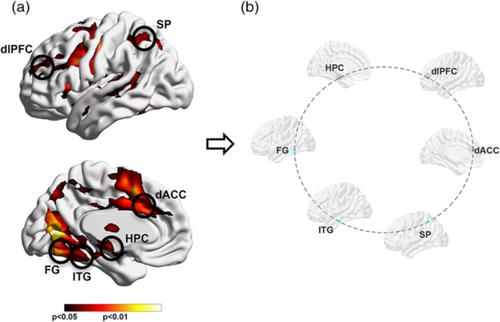当前位置:
X-MOL 学术
›
Hum. Brain Mapp.
›
论文详情
Our official English website, www.x-mol.net, welcomes your feedback! (Note: you will need to create a separate account there.)
Disordered directional brain network interactions during learning dynamics in schizophrenia revealed by multivariate autoregressive models.
Human Brain Mapping ( IF 4.8 ) Pub Date : 2020-05-21 , DOI: 10.1002/hbm.25032 Shahira J Baajour 1 , Asadur Chowdury 1 , Patricia Thomas 1 , Usha Rajan 1 , Dalal Khatib 1 , Caroline Zajac-Benitez 1 , Dimitri Falco 2 , Luay Haddad 1 , Alireza Amirsadri 1 , Steven Bressler 2, 3 , Jeffery A Stanley 1 , Vaibhav A Diwadkar 1
Human Brain Mapping ( IF 4.8 ) Pub Date : 2020-05-21 , DOI: 10.1002/hbm.25032 Shahira J Baajour 1 , Asadur Chowdury 1 , Patricia Thomas 1 , Usha Rajan 1 , Dalal Khatib 1 , Caroline Zajac-Benitez 1 , Dimitri Falco 2 , Luay Haddad 1 , Alireza Amirsadri 1 , Steven Bressler 2, 3 , Jeffery A Stanley 1 , Vaibhav A Diwadkar 1
Affiliation

|
Directional network interactions underpin normative brain function in key domains including associative learning. Schizophrenia (SCZ) is characterized by altered learning dynamics, yet dysfunctional directional functional connectivity (dFC) evoked during learning is rarely assessed. Here, nonlinear learning dynamics were induced using a paradigm alternating between conditions (Encoding and Retrieval). Evoked fMRI time series data were modeled using multivariate autoregressive (MVAR) models, to discover dysfunctional direction interactions between brain network constituents during learning stages (Early vs. Late), and conditions. A functionally derived subnetwork of coactivated (healthy controls [HC] ∩ SCZ] nodes was identified. MVAR models quantified directional interactions between pairs of nodes, and coefficients were evaluated for intergroup differences (HC ≠ SCZ). In exploratory analyses, we quantified statistical effects of neuroleptic dosage on performance and MVAR measures. During Early Encoding, SCZ showed reduced dFC within a frontal–hippocampal–fusiform network, though during Late Encoding reduced dFC was associated with pathways toward the dorsolateral prefrontal cortex (dlPFC). During Early Retrieval, SCZ showed increased dFC in pathways to and from the dorsal anterior cingulate cortex, though during Late Retrieval, patients showed increased dFC in pathways toward the dlPFC, but decreased dFC in pathways from the dlPFC. These discoveries constitute novel extensions of our understanding of task‐evoked dysconnection in schizophrenia and motivate understanding of the directional aspect of the dysconnection in schizophrenia. Disordered directionality should be investigated using computational psychiatric approaches that complement the MVAR method used in our work.
中文翻译:

多元自回归模型揭示精神分裂症学习动态过程中无序的定向脑网络相互作用。
定向网络交互支持包括联想学习在内的关键领域的规范大脑功能。精神分裂症 (SCZ) 的特点是学习动态改变,但很少评估学习期间诱发的功能失调的定向功能连接 (dFC)。在这里,使用在条件(编码和检索)之间交替的范式来诱导非线性学习动态。使用多变量自回归 (MVAR) 模型对诱发的 fMRI 时间序列数据进行建模,以发现学习阶段(早期与晚期)和条件下大脑网络成分之间功能失调的方向相互作用。功能衍生的共激活子网(健康对照 [HC] ∩SCZ]节点被识别。MVAR 模型量化了节点对之间的定向相互作用,并评估了组间差异(HC ≠ SCZ)的系数。在探索性分析中,我们量化了抗精神病药剂量对性能和 MVAR 测量的统计影响。在早期编码期间,SCZ 显示额叶 - 海马 - 梭形网络内的 dFC 减少,但在后期编码期间,减少的 dFC 与通往背外侧前额叶皮层 (dlPFC) 的通路有关。在早期的检索,SCZ在通路显示增加DFC并从背前扣带皮层,虽然后期检索时,病人表现的途径增加DFC朝的DLPFC,但在途径降低DFC从dlPFC。这些发现构成了我们对精神分裂症中任务诱发的连接障碍的理解的新扩展,并激发了对精神分裂症中连接障碍的定向方面的理解。应该使用计算精神病学方法来研究无序的方向性,这些方法补充了我们工作中使用的 MVAR 方法。
更新日期:2020-05-21
中文翻译:

多元自回归模型揭示精神分裂症学习动态过程中无序的定向脑网络相互作用。
定向网络交互支持包括联想学习在内的关键领域的规范大脑功能。精神分裂症 (SCZ) 的特点是学习动态改变,但很少评估学习期间诱发的功能失调的定向功能连接 (dFC)。在这里,使用在条件(编码和检索)之间交替的范式来诱导非线性学习动态。使用多变量自回归 (MVAR) 模型对诱发的 fMRI 时间序列数据进行建模,以发现学习阶段(早期与晚期)和条件下大脑网络成分之间功能失调的方向相互作用。功能衍生的共激活子网(健康对照 [HC] ∩SCZ]节点被识别。MVAR 模型量化了节点对之间的定向相互作用,并评估了组间差异(HC ≠ SCZ)的系数。在探索性分析中,我们量化了抗精神病药剂量对性能和 MVAR 测量的统计影响。在早期编码期间,SCZ 显示额叶 - 海马 - 梭形网络内的 dFC 减少,但在后期编码期间,减少的 dFC 与通往背外侧前额叶皮层 (dlPFC) 的通路有关。在早期的检索,SCZ在通路显示增加DFC并从背前扣带皮层,虽然后期检索时,病人表现的途径增加DFC朝的DLPFC,但在途径降低DFC从dlPFC。这些发现构成了我们对精神分裂症中任务诱发的连接障碍的理解的新扩展,并激发了对精神分裂症中连接障碍的定向方面的理解。应该使用计算精神病学方法来研究无序的方向性,这些方法补充了我们工作中使用的 MVAR 方法。


























 京公网安备 11010802027423号
京公网安备 11010802027423号